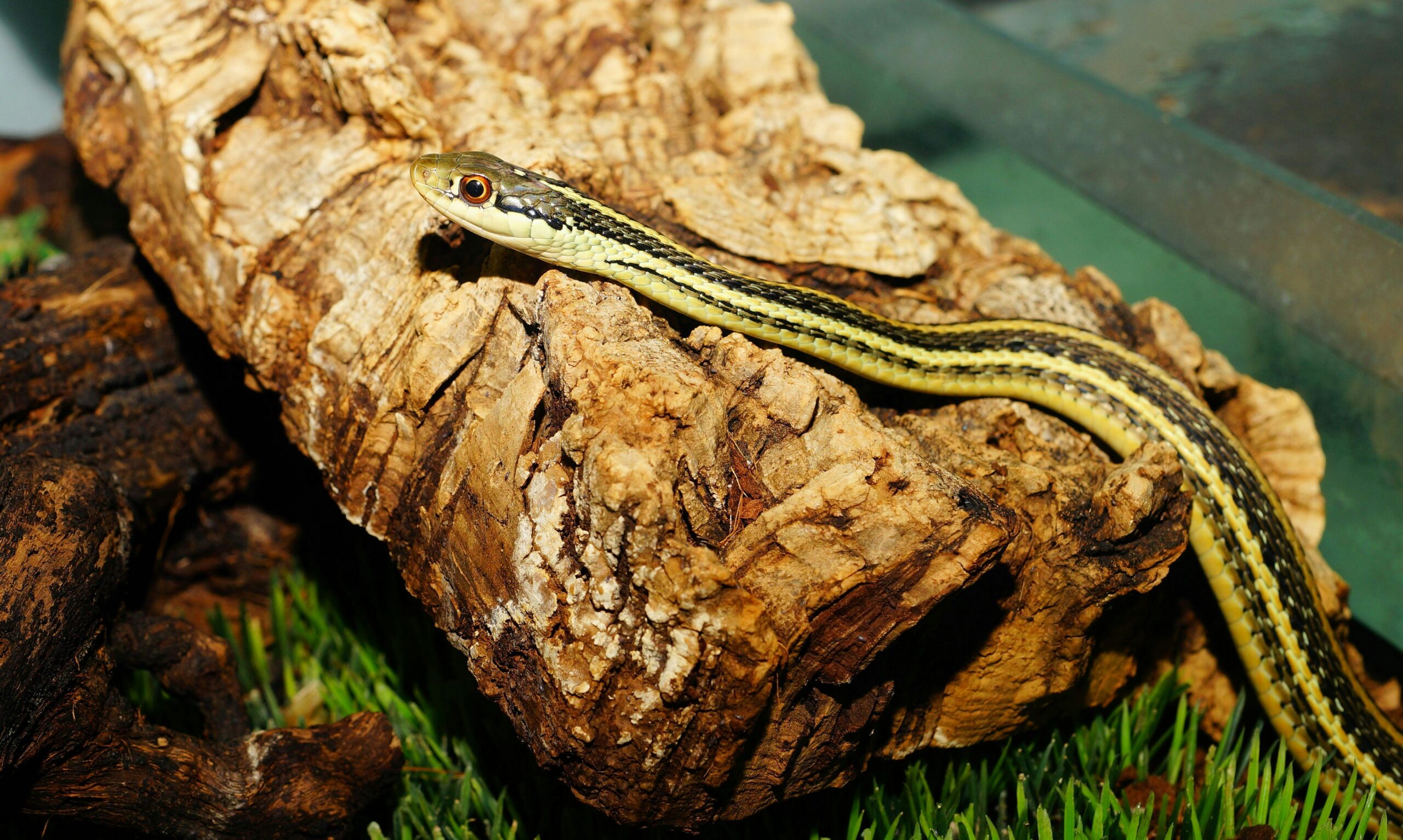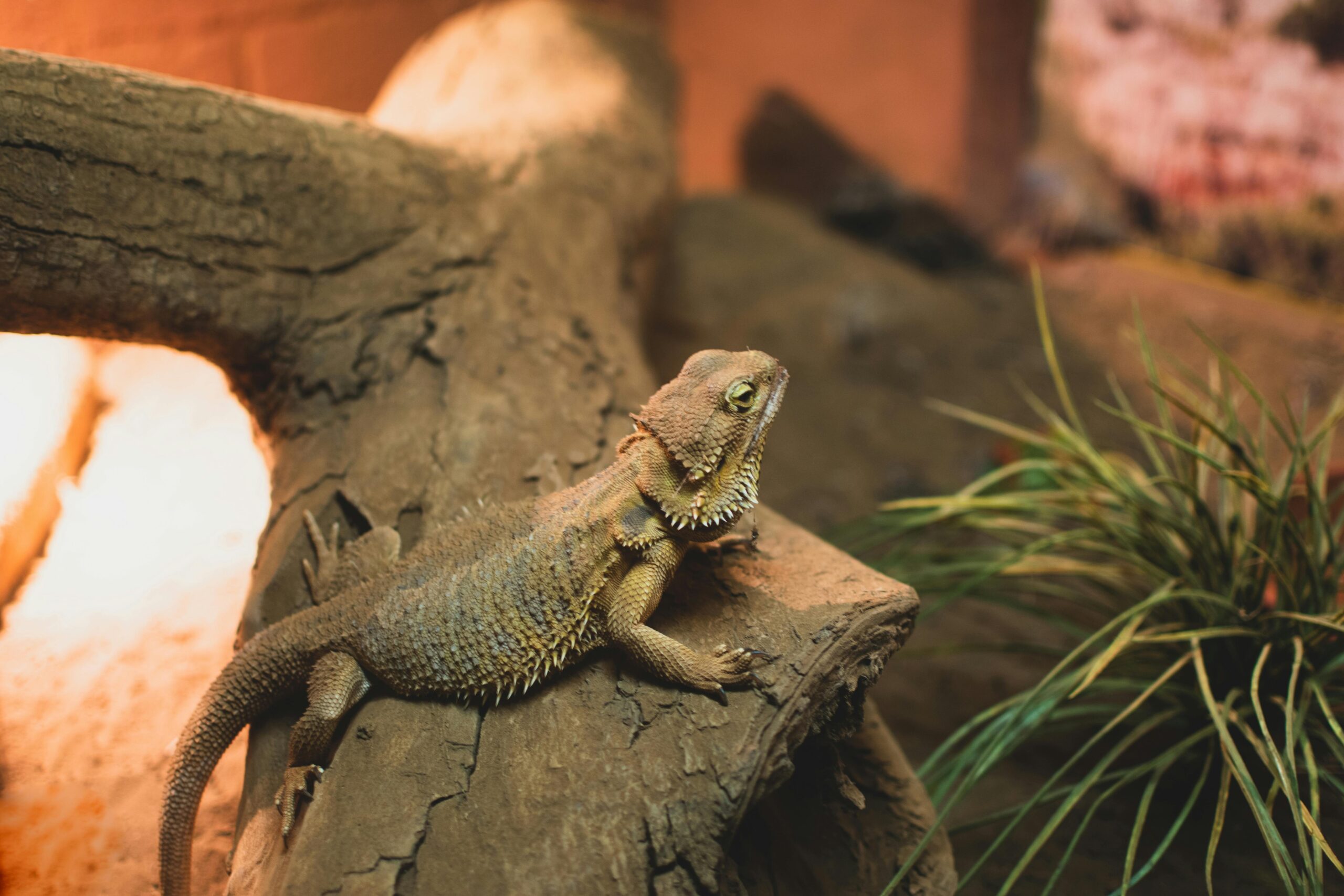Garter Snakes as Pets

A common garter snake (Thamnophis sirtalis) in an alert posture. Garter snakes (genus Thamnophis) are slender, striped colubrids native to North America. They include over 30 species (often called garters, ribbons, or water snakes) found across fields, forests, and wetlands. Most pet garters come from captive-bred stock, which tend to acclimate well. These diurnal snakes are active and curious: in the wild they hunt worms, fish and frogs near water. They generally tolerate gentle handling and, with good care, live 10–15 years (some even longer). (Keep in mind all reptiles can carry Salmonella, so practice good hygiene when handling.) Overall, garter snakes are hardy and rewarding pets for beginners and experts alike.
Garter Enclosure Size and Setup
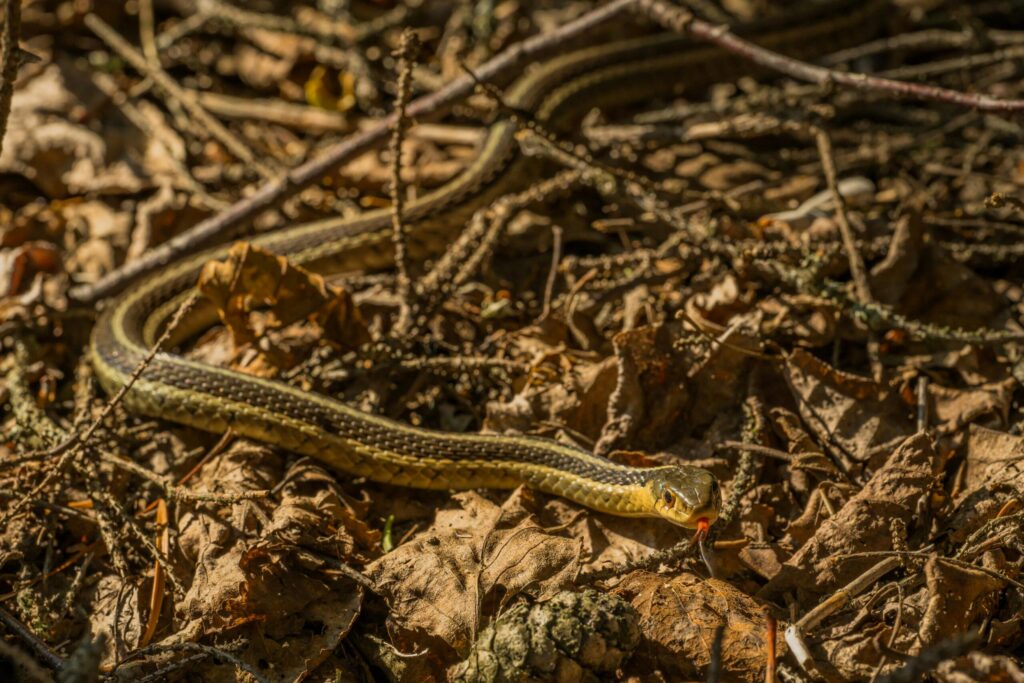
Garters are active and like to swim and climb, so roomy enclosures are essential. A single adult needs at least a 48″×24″×24″ terrarium (≈120×60×60 cm). In practice, many keepers use a 40–50 gallon (36–48″×18–24″ base) tank as a minimum. If you keep two garters together, bump up to ~55 gallons (≈48″×18″×18″) or larger. Taller cages (18″ or more) allow for branching and heat lamps safely. Always provide a temperature gradient: one end should be the warm “basking” area, and the other the cool side. Decorate with sturdy branches or cork bark for climbing and exercise, plus hiding spots on both ends so the snake can thermoregulate in privacy.
- Size guidelines: e.g. one ~3′ (36″) snake: ≥36″L×18″W×18″H (40–50 gal). One 3–4′ snake: ≥48″×24″×24″ (≈120 gal).
- Escape-proofing: Garter snakes are notorious escape artists. Use a front-opening, tight-seamed terrarium or PVC cage with secure latches. Check that all ventilation or mesh areas have no gaps.
- Multiple snakes: Garters can cohabit peacefully if same-sex and ample space. However, increase tank size for each additional snake. If you mix males and females, expect babies – garters are livebearers and breed readily. Avoid housing species known to be cannibalistic together such as the western terrestrial garter snake or checkered garter snake variety.
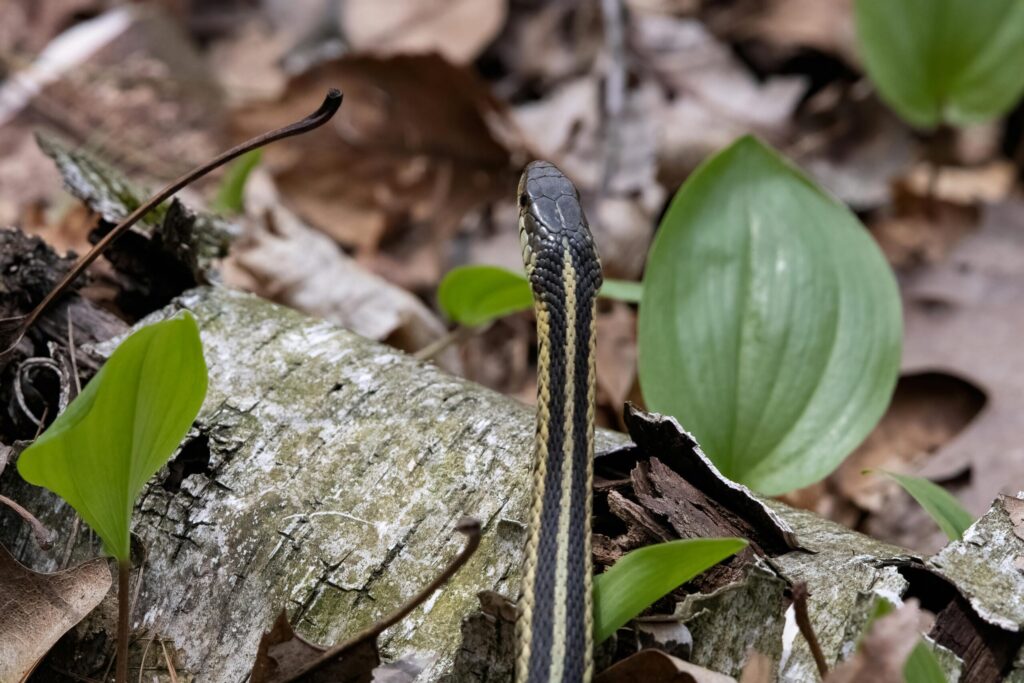
Garter Substrate Options
Choose a bedding that holds moderate moisture and mimics natural leaf litter or soil. Good substrates include:
- Coconut fiber/eco-earth: (e.g. Zoo Med Eco Earth or Reptisoil) absorbs moisture and lets garters burrow.
- Topsoil mixtures: Organic, pesticide-free topsoil mixed with play sand (≈40% soil, 20% sand) for drainage.
- Cypress mulch or bark: Adds humidity and a natural look. Use clean, dust-free brands. Leaf litter (oak, magnolia, etc.) on top of substrate also aids humidity retention.
- Aspen shavings: Can work in dry setups. It’s breathable but molds in damp conditions, so use this primarily with species from low-humidity regions.
- Depth: Provide ≥2″ substrate so the snake can coil and hide; more depth (3–4″) is fine for burrowing species.
Avoid:
very dusty or irritating materials. Do not use sand, clay-based cat litter, cedar, pine, or untreated soil from outdoors. These can cause breathing or skin problems. Newspaper or paper towels are okay for very young snakes, but for adults use more natural bedding to allow for digging and humidity control.
If you would like to consider a safer option you can always use news paper or paper towels with sick snakes or in an effort to prevent impaction from your snake accidently consuming naturalistic substrate or other indigestible items. These substrates are both safer for the snake and much easier to clean and maintain. However, they do not provide the same naturalistic appeal of the zoo quality enclosures most keepers want for their pets and considering most reptiles don’t die from consuming substrate in the wild, impaction is incredibly rare when caused by substrate. Impaction is usually imposed by other factors contributing to an animals health such as dehydration, underheating, inadequate UVB or supplementation, lack of exercise or pre-existing illness. If your animal is showing signs of impaction your exotic veterinarian will likely consider these factors in addition to the substrate you use.
Spot-clean the substrate daily by removing feces and shed skin. Fully replace all substrate every 3–4 months to prevent bacterial buildup.

Garter Heating and Lighting Requirements
Garter snakes are ectothermic and need a warm area to digest food and cool area to rest. Set up a temperature gradient in the cage:
- Basking zone: ≈85–90 °F (29–32 °C). Use a ceramic heat emitter or basking bulb with thermostat control to maintain this spot. (Some care guides say 90–95 °F; keep around 90 °F to be safe.)
- Cool zone: ≈75–80 °F (23–27 °C) on the opposite side.
- Night temps: It’s fine if the whole tank drops to about 64–75 °F (18–24 °C) overnight. Avoid letting temps rise above 91 °F (33 °C) anywhere, as high heat stresses garters.
- Thermostat: Always run heat sources through a reliable thermostat to prevent overheating. Turn heat off at night if temps are within safe range; this helps simulate natural night cooling.
For lighting, garters are daytime-active. Provide ~12–14 hours of light in summer and ~10 hours in winter to mimic seasons. Programmable timers (even smart plugs) make this easy. Bright white full-spectrum lamps (e.g. 6500K LED or T5 bulbs) over the enclosure encourage activity and support any live plants.
UVB light: While garters can survive without UVB, it’s recommended for optimal health. Use a 5.0%–6.0% UVB T5 fluorescent tube spanning half the tank on the warm side. Mount it above the mesh cover. Aim for a UV Index (UVI) of about 2.0–3.0 at the basking spot (using a UV meter can verify this, as advanced keepers do). UVB helps Vitamin D3 synthesis and calcium metabolism. Always ensure snakes can retreat from light into shade.
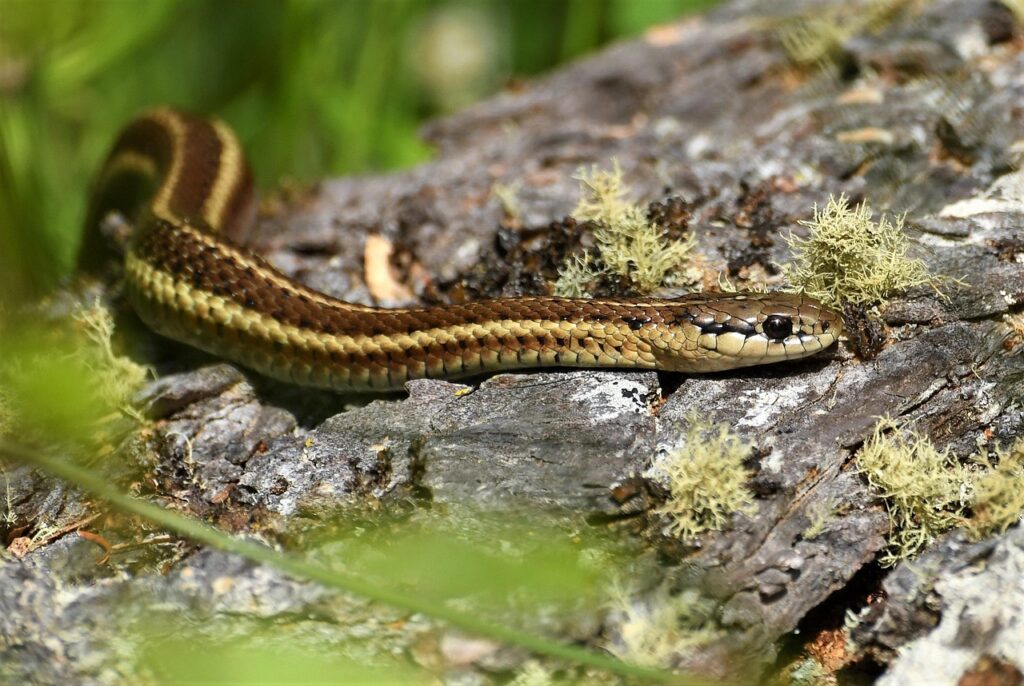
Garter Humidity and Water Needs
Garter snakes prefer moderate humidity. Maintain about 40–60% humidity in the enclosure. It’s normal for the cool end to be more humid than the warm side. Use a hygrometer to check levels. To increase humidity:
- Mist the tank lightly once or twice a day, especially during dry spells.
- Provide a moist hide: a hide box lined with damp (not wet) sphagnum moss or paper towels will give the snake a humid retreat during shedding. Change the moss often to avoid mold.
- A generous layer of leaf litter or bark mulch over the substrate helps trap moisture.
- Take care not to flood the tank; constant dampness can cause scale rot. Aim for humidity on the lower end of the above range on the warm side, and let it spike in the cool/moist hide.
Water dish: Always offer clean water. Garters often soak and even swim, so use a bowl big enough for the snake to fully or partially submerge. A shallow plastic tub (e.g. 8–12″ long, 6–8″ wide) or glass dish works for adults. Change the water daily (more often if feces are present), and scrub the dish weekly with reptile-safe disinfectant. During shedding, snakes will soak more, so keep water fresh. In winter low-humidity months you may even partially cover a mesh lid to boost humidity.

Feeding and Diet
Garter snakes are carnivores that thrive on a varied diet. Offer appropriately sized whole prey about 10% of the snake’s body weight (prey roughly ≤1.5× the snake’s mid-body width). Typical feeding schedules are:
- Newborns (6–8″): Feed every 1–2 days.
- Juveniles: Feed every 3–5 days.
- Adults: Feed every 4–7 days.
Use long tongs to present food and avoid hand-feeding to prevent accidental bites (garters can be quick and have sharp teeth). Remove any uneaten prey after ~1 hour. Adjust frequency if the snake begins to refuse meals or gains too much weight.
Diet variety (key to health):
Wild garters eat worms, fish, amphibians, and small mammals. Captive diets should mimic this diversity:
- Earthworms: Large nightcrawlers or commercial worms (brown wigglers), chopped for tiny snakes. Worms are highly nutritious and loved by most garters so they should be a staple in your pets diet.
- Fish: Small minnows or guppies work (live or pre-killed). Use sparingly: many fish contain thiaminase, an enzyme that breaks down vitamin B1. Long-term exclusive fish diets can cause deficiencies in addition to excessive parasite load. Variety is safer but fish should still be offered sparingly.
- Amphibians: Tadpoles, newts, or frogs (captive-bred without pesticides) can be offered sparingly if legal in your area. Always gut-load and ensure they’re healthy before feeding.
- Rodents: Pinkie or fuzzy mice can be given to larger adults. Even though garters are “fish eaters” by reputation, many will take pinkies eagerly. Remove leftover rodent parts to avoid spoilage.
- Eggs: Hard-boiled quail or chicken eggs (cut into pieces) are a nutritious occasional treat.
- Commercial feeds: Garter-specific diets (like Reptilinks) can supplement variety but should not be the snakes sole food source.
- Supplements: Garter snakes don’t strictly need dusting, but light supplementation can prevent gaps. Dust prey with a 50/50 mix of calcium and reptile multivitamin (with D3) every 4–6 feeds. Arcadia Reptivite or Repashy CalciumPlus are suitable choices.
What to avoid:
Do not feed Garter Snakes hard-bodied insects like crickets or mealworms; garters generally ignore these. Avoid raw goldfish long-term because of the enzyme issue. Never use wild fish or invertebrates (leeches, snails) without ensuring they’re disease-free.
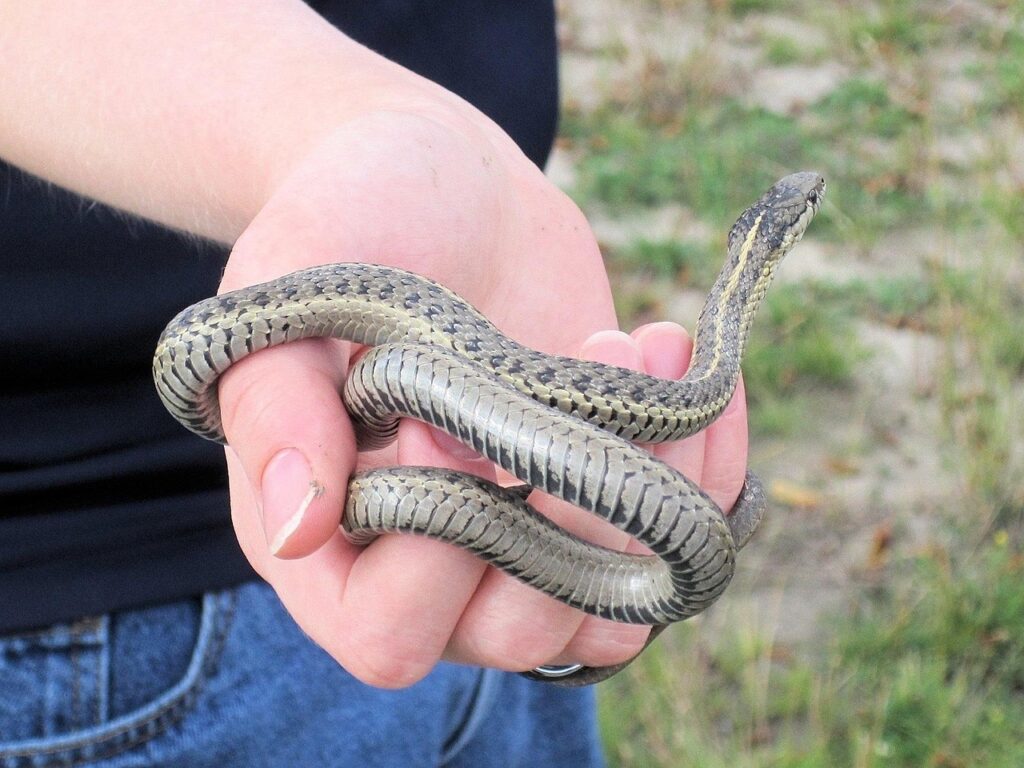
Garter Handling and Enrichment
Garter snakes can become tame pets with gentle, consistent handling. Begin slowly: wait ~1–2 weeks after bringing a new snake home, until it’s feeding and exploring normally. Then start with short (5–10 minute) handling sessions once a week. Always support the snake’s body fully and let it crawl onto your hand rather than grabbing it suddenly. Lift from below (avoid coming over the top of its head) and move slowly; sudden motions can startle them. Most captive-born garters tolerate handling well by adulthood. If your snake coils defensively or strikes when handled, give it more time and don’t force interactions until it calms. Washing hands before and after handling is important for both your hygiene and to avoid transferring scents that might excite or stress the snake.
Enrichment:
Besides climbing branches and hides mentioned above, there are easy ways to make life interesting for your Garter Snake. Scatter leaf litter or safe foliage on the floor of the cage; garters will burrow and explore. Adding safe, sturdy live plants (e.g., pothos, dracaena) or artificial vines provides cover and climbing options. You can also feed prey in varied ways: for example, gently move a fish on tongs to simulate movement, or place earthworms partially in a hide so the snake has to find them. Some keepers set up a shallow “pool” area with water-clean substrate for the snake to swim in when supervised. Finally, consider cohabitation (for advanced keepers): juveniles often do fine in small groups and may feel more secure, but always ensure enough space and food to prevent aggression.

Common Health Issues and Prevention
Most health problems in garter snakes stem from husbandry lapses. Good tank conditions and hygiene go a long way toward prevention. Common issues include:
- Respiratory infection (pneumonia): Often caused by low temperatures or excessive humidity. Signs include wheezing, bubbles or mucus around the nose/mouth, open-mouth breathing, lethargy, and refusal to eat. If suspected, consult a reptile vet. Prevent by maintaining proper heat and ventilation at all times.
- Internal parasites: Worms, flukes, and protozoa are common in wild-caught snakes and can persist even in some hatchlings. They may cause diarrhea, weight loss, or poor growth. Have fecal exams done on new snakes and periodically on established pets. Treat any infections with vet-prescribed dewormers. Good prevention: source captive-bred animals and quarantine newcomers.
- External parasites (mites): Snake mites (Ophionyssus natricis) are tiny reddish/black pests that crawl on skin. They suck blood and cause irritation, lethargy, and can transmit disease. Check new or wild snakes carefully (mites fall off into water dishes). If you see mites, treat immediately with reptile-safe products and thoroughly clean the cage. Quarantine all new or sick snakes to stop mite spread.
- Skin/scale infections (“blister disease” or scale rot): These bacterial infections result from keeping the cage too wet or unclean. Early signs are red or yellow patches/blisters on the belly scales. Prevent by cleaning waste promptly, providing both dry and moist areas, and not over-misting the habitat.
- Retained shed: If humidity is too low, a garter may shed incompletely, leaving skin or eye caps behind. Providing a moist hide and fresh water bowl for soaking usually solves this. Never forcibly remove stuck shed.
- Mouth rot (infectious stomatitis): Look for discolored or inflamed gums, pus, or a foul smell from the mouth. It results from injury or weakened immunity. Prevent by feeding appropriate prey and not handling right after meals. A vet will need to prescribe antibiotics if mouth rot develops.
- Other: Burns from heat sources (use protected fixtures), impaction from ingesting substrate (fine sand or litter can cause blockage), obesity from overfeeding, and constipation (ensure hydration).
Preventive care:
Change water daily and fully disinfect the water dish weekly to keep your Garter Snake happy and healthy. Spot-clean feces immediately and do complete substrate changes every 3–4 months. Use hide boxes of various sizes so your snake always has a snug retreat. Keep records of your snake’s weight and behavior – subtle changes can signal health issues early. And of course, wash hands before/after tank maintenance to avoid spreading germs.
Additional Health Issues and Mitigation
- Metabolic Bone Disease (MBD): A common nutritional disorder caused by an imbalance of calcium, phosphorus, or lack of UVB exposure, leading to weakened, deformed bones and muscle tremors. Prevent by ensuring a proper dietary Ca:P ratio, dusting prey with calcium/vitamin D3 supplements, and providing adequate UVB lighting (thesprucepets.com).
- Septicemia (Blood Poisoning): Systemic bacterial infection from untreated wounds or poor hygiene, characterized by lethargy, swelling, and discoloration. Mitigate by promptly cleaning and disinfecting any wounds, maintaining strict enclosure hygiene, and seeking veterinary antibiotic therapy when needed (vcahospitals.com).
- Inclusion Body Disease (IBD): A viral illness mostly in boas and pythons but occasionally reported in other snakes, presenting with neurological signs, regurgitation, and poor coordination. Prevent by strict quarantine of new snakes, regular veterinary check‑ups, and thorough disinfection of all equipment (vcahospitals.com).
- Thermal Burns: Injury from direct contact with unguarded heat sources, seen as blistering or blackened scales. Avoid by using protected fixtures, accurate thermostats, and maintaining recommended distances between snakes and heat elements (rspca.org.uk).
- Impaction: Gastrointestinal blockage from ingesting substrate or large prey items, causing anorexia, abdominal swelling, and constipation. Prevent by offering food on a clean surface, using impaction‑safe substrates, and ensuring proper hydration (thebiodude.com).
- Obesity: Excessive fat deposition due to overfeeding and sedentary lifestyle, leading to fatty liver disease and reproductive issues. Mitigate by monitoring body condition, adjusting feeding schedules and portion sizes, and providing environmental enrichment to encourage natural activity (rspca.org.uk).

Tips for Advanced Keepers
- Quarantine: Always isolate new snakes for 1–3 months before introducing them to an established collection. This prevents disease/parasite spread. Consider routine deworming during quarantine.
- Co-housing & Breeding: For those interested in breeding, keep males and females together only under controlled conditions. Monitor gravid females carefully (they give live birth). If you prefer not to breed, separate sexes. Note that some garter species or individuals may practice filial cannibalism (eating their own young) if stressed, so provide ample cover.
- Lighting fine-tuning: Use a UV index meter (Solarmeter) to verify your UVB lamp’s output and adjust distance for a UVI of ~2.0 at the basking spot. Advanced keepers sometimes supplement with discrete UVA or broad-spectrum LED lights to mimic natural sunlight even better.
- Bioactive setups: If you enjoy naturalistic vivaria, you can create a bioactive tank. Include clean-up crew organisms like springtails and isopods in the substrate, and plant live, non-toxic flora that tolerate occasional flooding. This turns waste into food for the microfauna and helps maintain plant life. Use sterilized plant soil.
- Temperature control: Invest in precise thermostats and even thermal probes to log temperatures over time. A smart thermostat or app-controlled outlet can automate day/night cycle changes. This is handy for simulating seasonal light shifts, which some breeders use to trigger breeding behavior.
- Food sources: Some advanced keepers culture their own food – e.g. breeding earthworms or feeder fish. This ensures a reliable, chemical-free diet. You can also rotate prey types (e.g. switch between fish, worms, and pinkie mice over weeks) to ensure balanced nutrition and mental stimulation. Use gut-loaded or vitamin-fortified prey when possible.
- Monitoring health: Keep a log of shed quality, appetite, and behavior. Unexpected loss of appetite is a key early warning. Weigh your snake monthly. Consider periodic fecal exams at a reptile vet as part of wellness checks, especially for wild-caught imports.
Remember:
No two garter snakes are identical – learn the natural history of your specific species (Western, Eastern, Checkered, etc.). Some prefer cooler climates, others need warmer conditions. Read up on your snake’s origin. And lastly, check local laws: certain subspecies (e.g. T. s. tetrataenia, the San Francisco garter) are protected and illegal to keep. By staying informed and attentive, you’ll enjoy a healthy, vibrant garter snake and the rewards of responsible reptile keeping. For more tips and tricks to care for other animals, visit our website here today!
Sources:
Mullinax, Mariah Healey. “Garter Snake (Thamnophis spp.) Care Sheet.” ReptiFiles, https://reptifiles.com/garter-snake-care-sheet/. Accessed 29 Apr. 2025.
McLeod, Lianne. “Metabolic Bone Disease in Reptiles.” The Spruce Pets, Dotdash Meredith, 27 Mar. 2022, https://www.thesprucepets.com/metabolic-bone-disease-in-reptiles-1237237. Accessed 29 Apr. 2025.
“Common Diseases of Pet Snakes.” VCA Animal Hospitals, https://vcahospitals.com/know-your-pet/snakes-diseases. Accessed 29 Apr. 2025.
PetMD Editorial. “Skeletal Deformity in Amphibians.” PetMD, 14 Aug. 2008, https://www.petmd.com/reptile/conditions/musculoskeletal/c_rp_am_metabolic_bone. Accessed 29 Apr. 2025.
“Garter Snake.” RSPCA, https://www.rspca.org.uk/adviceandwelfare/pets/other/gartersnake. Accessed 29 Apr. 2025.
Merck Veterinary Manual. “Disorders and Diseases of Reptiles.” Merck Veterinary Manual, https://www.merckvetmanual.com/all-other-pets/reptiles/disorders-and-diseases-of-reptiles. Accessed 29 Apr. 2025.
The Bio Dude. “Do Substrates Cause Impaction in Reptiles?” The Bio Dude, 4.7 years ago, https://www.thebiodude.com/blogs/reptile-and-amphibian-husbandry-basics/does-substrates-cause-impaction-in-reptiles. Accessed 29 Apr. 2025.
